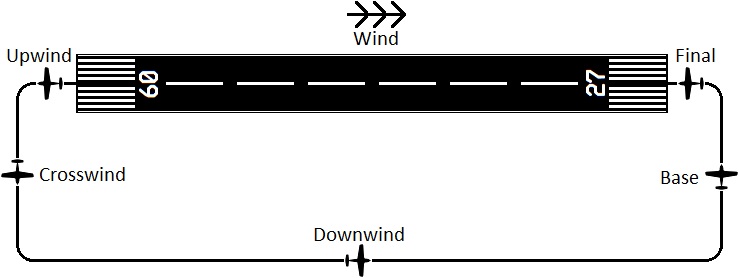My lesson today was at 9am, I arrived before Derek and was told to go and run through a “full A check” on my own. I hadn’t been explicitly told about this before, but I’d read about it on Nic Rodgers great Learning to Fly blog, It’s basically just ensuring you go through everything on the check-list thoroughly as well as checking the fuel. It was this last part that I hadn’t done yet.
I made my way out to the aeroplane, G-AXTL, the same one as last lesson and completed all the checks except for the fuel. Derek soon joined me but came with the news that we couldn’t use this plane for circuits as its engine was too new. Derek and I went back to the club to arrange switching aeroplanes and while there briefed me on today’s lesson.
A circuit is where you take off, turn around and fly parallel to the runway, turn back towards the airfield and land. Then you take off again without stopping and repeat this over and over practising all the things you’ve learnt so far; climbs, turns, descents, slow flight and now landings.

When you take off you want to fly into wind as much as possible; with the aircraft moving forward and the wind blowing towards you, the air is moving faster over the wings than if the wind was blowing from behind you. When you take off you are said to be flying “upwind”; once you get to about 500 feet above the ground you must perform a rate one turn, a climbing turn limited to 15°. The wind will now be blowing across your wings rather than over them, and this is called the “crosswind” leg. At 1,000 feet you level off, speed up to a normal cruise and then turn to fly back down the length of the runway. Now the wind will be blowing from behind you and this is called the “downwind” leg. It is at this point that you radio the tower to tell them you’re downwind and run through the (rather funny sounding) BUMPFFICH checks. These are:
- Brakes - off
- Undercarriage - fixed
- Mixture - rich
- Pitch - fixed
- Fuel - on
- Fuel pump - on
- Instruments - checked, DI aligned & gauges in the green
- Carburettor heat - on for 30 seconds to check for icing
- Hatches and harnesses - secure
You may wonder why we check the undercarriage and pitch in a plane where they are both fixed. Well, it’s so that if we were to ever fly an aeroplane with retractable landing gear or with a variable pitch propeller you wouldn’t need to learn a different check-list.
Once past the end of the runway you turn again, now with the wind blowing across not over your wings (like on crosswind), but this time it’s called the “base” leg. It’s here you would start your descent; first apply carburettor heat then reduce engine RPM to 1,500, holding the nose up while you slow down. As the speed reduces you apply one stage of flaps. When the speed has reaches 70 knots, you lower the nose to maintain that speed and the descent starts. When you’re sure you’ll be able to land, you apply the second stage of flaps.
At about 600 feet you turn for the final time, this time aiming towards the runway centre-line, this is known as being on “final”. Now you must contact the tower and get permission to land, all the while ensuring your speed is steady at 70 knots and your approach isn’t too shallow or steep. You control your speed with the stick and your angle of descent with the engine RPM as mentioned last lesson. When you’re at about 300 feet and sure to make the runway, you can apply the last stage of flap.
As you descend over the runway you need to flare the aeroplane and stop it from landing. As long as this is done about 15 feet from the tarmac you will slow down and gently land without a bump. Then bring the flaps up, turn the carburettor heat back off, apply full power and take off to fly the circuit again!
After that rather involved briefing it was time to go flying, this time in G-BCJN, a Piper PA-28-140 Cherokee I’d flown before. We went through the checks together and Derek showed me how to test the fuel. You use a small clear container (something else I’d need to buy before next lesson) to extract a little fuel from a valve on the underside of each wing and check there’s no water at the bottom or contaminates floating around. The colour is a light blue and it smells of AVGAS, not diesel.
We took off and Derek talked me through the first circuit, reminding me when to radio the tower and what checks I needed to do. He took control for the first landing, then it was my turn. I flew the circuit again but this time I had control all the way down to the runway with Derek just there to help me if I struggled.
My first landing was a little bumpy, my second was much too high and we came down with a heavy jolt. The next two landings were okay and after my last attempt Derek exclaimed “what a lovely landing”! I felt thrilled, but in truth Derek had been coaching me very closely all the way down, so I’m not sure how I would have fared if he’d said nothing. But for a first lesson in circuits I was very pleased.